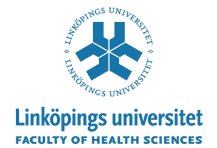|
|
| |
| COURSE TITLE |
| Oral and Verbal Apraxia in Children; Assessment, Diagnostics,
7,5 points |
| |
COURSE CATEGORY Programkurs
MAIN FIELD OF STUDY
SUBJECT AREA
|
|
COURSE CODE |
|
8FA046 |
|
| AIM OF THE COURSE |
The course is elective and primarily aimed for students at the master programme in clinical science with a focus on speech and language pathology. The course will be held in English
Knowledge and comprehension
After a completed course the student will be able to:
• Describe and relate basic terminology in human genetic diagnostics
• Describe inherited and genetic deviations related to oral motor function and speech
• Recognise possibilities and constraints with different neurological and neurophysiological methods including brain imaging
• Recognise and in detail describe the speech production process, including linguistic-, motor- and acoustic-aspects
Skills and abilities
After a completed course the student will be able to:
• Apply relevant speech, language pathology examinations in the assessment of oral motor function and speech problems
• Classify oral motor problems and speech difficulties depending on assessment outcomes
Judgements and attitudes
After a completed course the student will be able to:
• Appraise, act and communicate depending on a syntheses of assessment outcome |
| CONTENTS |
The course content will be discussed and illuminated by lectures, laboratory work, field studies and seminars.
|
| TEACHING |
The Faculty of Health Sciences at Linköping University has Problem Based Learning (PBL) as its pedagogical philosophy and method. PBL means that focus is placed on student involvement in the learning process. The student assumes responsibility for what he/she needs to learn, by analysing and dealing with situations associated with professional practice both in theoretical and practical study. The student seeks knowledge, selects, applies and evaluates this, and his/her learning in relation to individual learning goals. The teaching aims to stimulate and support the student’s development of professional competence and self-governed learning.
Teaching in this course will be provided through lectures, laboratory work, field studies and seminars.
|
| EXAMINATION |
| Course examination is through a small scientific project presented orally and as a paper at a seminar. |
| ADMISSION REQUIREMENTS |
Academic degree on Bachelors level in speech and language pathology or from adjacent subject areas.
Documented knowledge of English equivalent to ”Engelska B”; i.e. English as native language or an internationally recognized test, e.g. TOEFL (miminum scores: Paperbased 550 + TWE-score 4.0, computerbased 213 and internetbased 79), IELTS, academic (minimum score: Overall band 6.0 and no band under 5.0), or equivalent. |
| GRADING |
| The course is graded on the following scale: Pass; Fail. |
| CERTIFICATE |
| Course certificate is issued by the Faculty Board on request. The Department provides a special form which should be submitted to the Student Affairs Office at the Faculty of Health Sciences. |
| COURSE LITERATURE |
| The course literature is decided upon by the department
in question. |
| OTHER INFORMATION |
The planning and implementation of a course must take its starting point in the wording of the syllabus. The course evaluation included in each course must therefore take up the question how well the course agrees will the syllabus.
The course is carried out in such a way that both men’s and women’s experience and knowledge is made visible and developed.
If the course is discontinued or going through major revisions, examination opportunities are normally rendered according to the present course outline on three occasions within a year, one in close adjunction to the first examination date.
|
| |
Oral and Verbal Apraxia in Children; Assessment, Diagnostics
Oral and Verbal Apraxia in Children; Assessment, Diagnostics, Therapy, advanced course |
| |
Department responsible
for
the course or
equivalent:
INR-Institutionen för nervsystem och rörelseorgan |
| |
|
|
|
|
|
| Registrar No: 1410/06-41 |
|
Course Code: 8FA046 |
|
|
|
| |
|
Exam codes: see Local Computer System |
|
|
|
| Subject/Subject Area : |
|
|
|
|
|
| |
|
|
|
|
|
| Level |
|
Education level |
|
|
Subject Area Code |
|
Field of Education |
|
| Avancerad |
|
|
|
|
LDA |
|
Medicin |
|
|
|
|
|
| |
